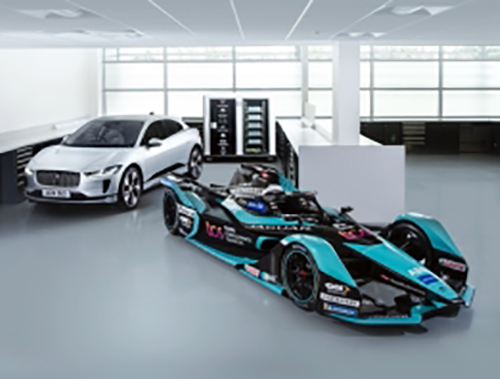Jaguar Land Rover has partnered with Pramac, a global leader in the energy sector, to develop a portable zero-emission energy storage unit powered by second-life Jaguar I-PACE batteries.
Called the Off Grid Battery Energy Storage System (ESS), Pramac’s technology – which features lithium-ion cells from Jaguar I-PACE batteries taken from prototype and engineering test vehicles, supplies zero-emission power where access to the mains supply is limited or unavailable.
The partnership is the first in Jaguar Land Rover’s plans to create new circular economy business models for its vehicle batteries. As part of its commitment to net zero status by 2039, the company will be launching programmes that deliver second life and beyond uses for its electric vehicle batteries.
Post-vehicle applications exist because Jaguar Land Rover’s batteries are engineered to the highest standards and can therefore be safely deployed in multiple low-energy situations once battery health falls below the stringent requirements of an electric vehicle. Second-life battery supply for stationary applications, like renewable energy storage, could exceed 200 gigawatt-hours per year by 2030, creating a global value over $30 billion*.
The flagship system has a capacity of up to 125kWh – more than enough to fully charge Jaguar’s multi-award-winning all-electric I-PACE performance SUV, or to power a regular family home for a week**. Pramac directly reuses up to 85% of the vehicle battery supplied by Jaguar Land Rover within the storage unit, including modules and wiring. The remaining materials are recycled back into the supply chain.
Charged from solar panels, the unit is a self-contained solution that consists of a battery system linked to a bi-directional converter and the associated control management systems. Available for commercial hire, the units are fitted with Type 2 Electric Vehicle (EV) charge connections with dynamic control and rated at up to 22kW AC to allow electric vehicle charging.
To showcase its capability, the unit helped Jaguar TCS Racing prepare for the 2022 ABB FIA Formula E World Championship during testing in the UK and Spain, where it was used to run the team’s cutting-edge diagnostic equipment analysing the race cars’ track performance, and to supply auxiliary power to the Jaguar pit garage.
An Off Grid Battery ESS will also be deployed at Jaguar Land Rover Experience Centre in Johannesburg, South Africa – the world’s biggest – to help the site cope with inconsistent power delivery from the mains.
Andrew Whitworth, Battery Manager, Circular Economy Team at Jaguar Land Rover, said: “This announcement is a great example of how we will collaborate with industry leaders to deliver our sustainable future and achieve a truly circular economy. We’re delighted to be working with Pramac to use Jaguar I-PACE second-life batteries to provide portable zero-emissions power and supporting Jaguar TCS Racing this season was an excellent opportunity to demonstrate what these units are capable of.”
François Dossa, Executive Director for Strategy & Sustainability, Jaguar Land Rover, said: “The transition to an electric future, with Jaguar becoming all-electric from 2025 and the first all-electric Land Rover model expected in 2024, is integral to our sustainability strategy through the development of a comprehensive EV ecosystem from batteries to charging. This includes our effort to enable technical and business innovations for battery reuse for second life applications. Our collaboration with Pramac is a proof point in such direction, showing how it’s possible to supply zero-emission power through the combination of renewables and second life batteries. Through their testing at Valencia, the Jaguar TCS Racing team have shown how we can inspire the whole ecosystem to continue to explore synergies and validate viable solutions for clean energy.”
Danny Jones, Director, Pramac, said: “We have been privileged to work so closely with Jaguar Land Rover who are a hugely supportive partner in our journey to successfully build a robust product and a commercially viable business case using second-life EV modules. This brings a new element to the sustainability story as a manufacturer of energy efficient and carbon reducing technology. We look forward to continuing the journey with Jaguar Land Rover and providing innovative charging infrastructure solutions to support the electrification of their class-leading vehicles.”

COMMENTS